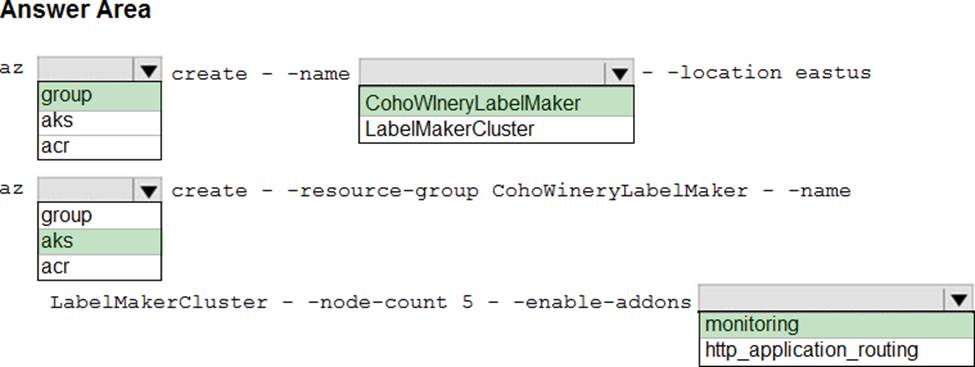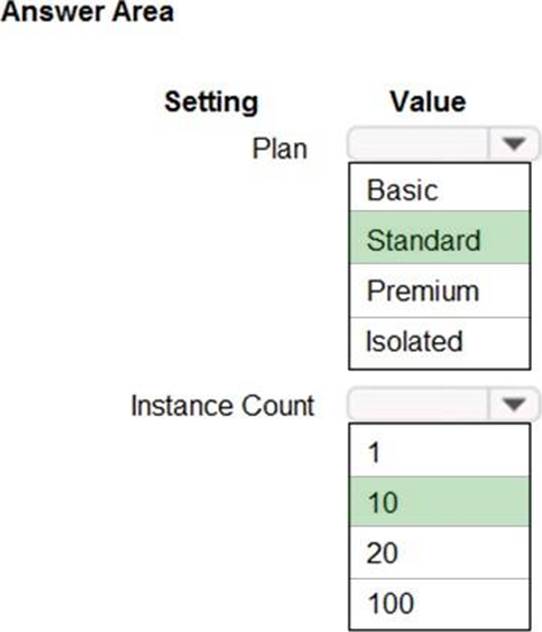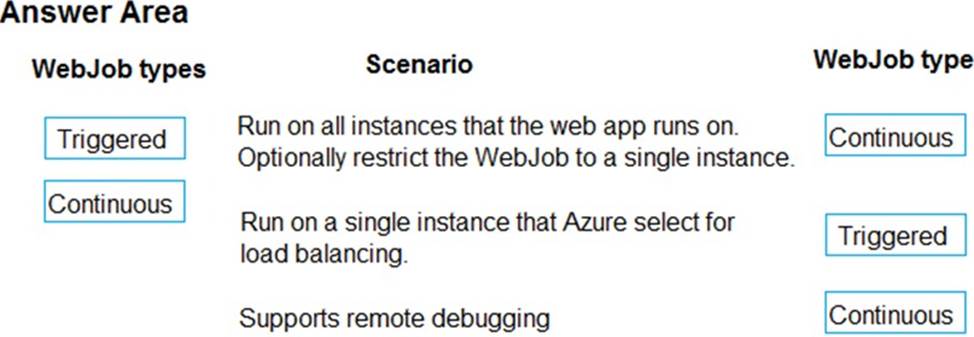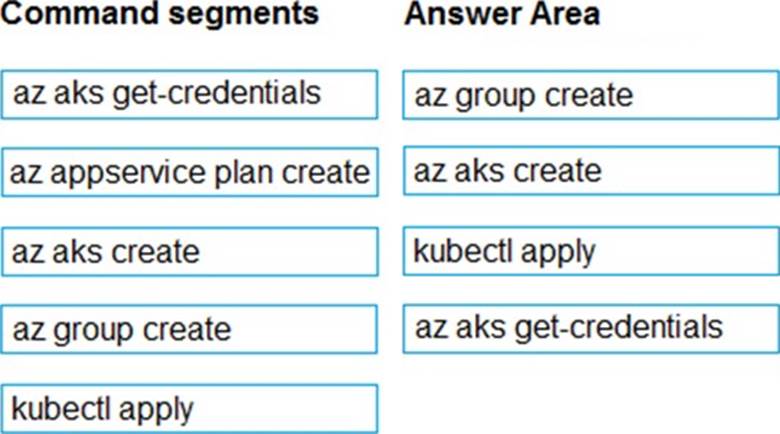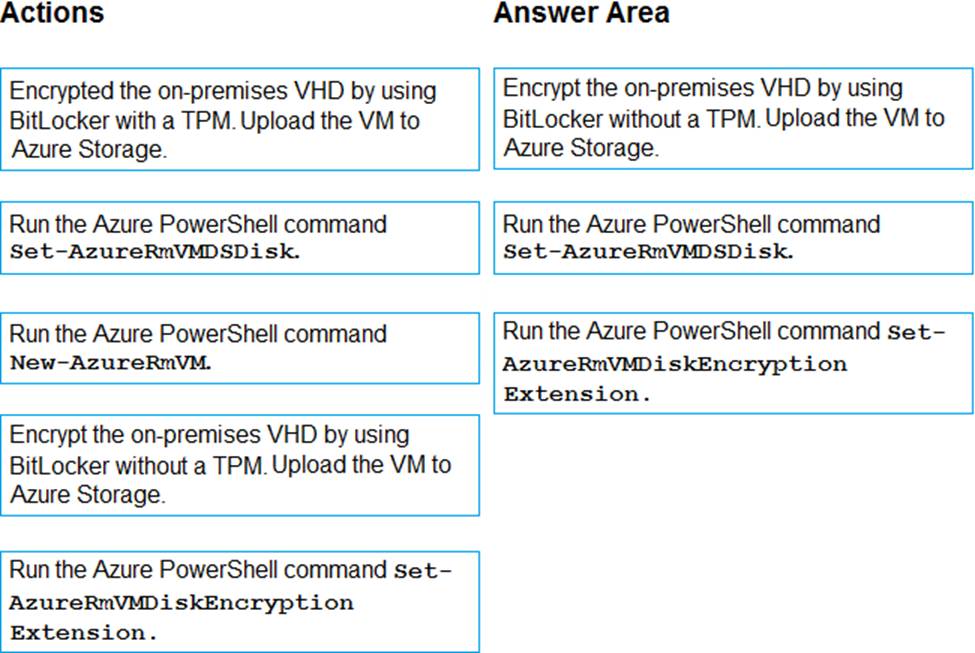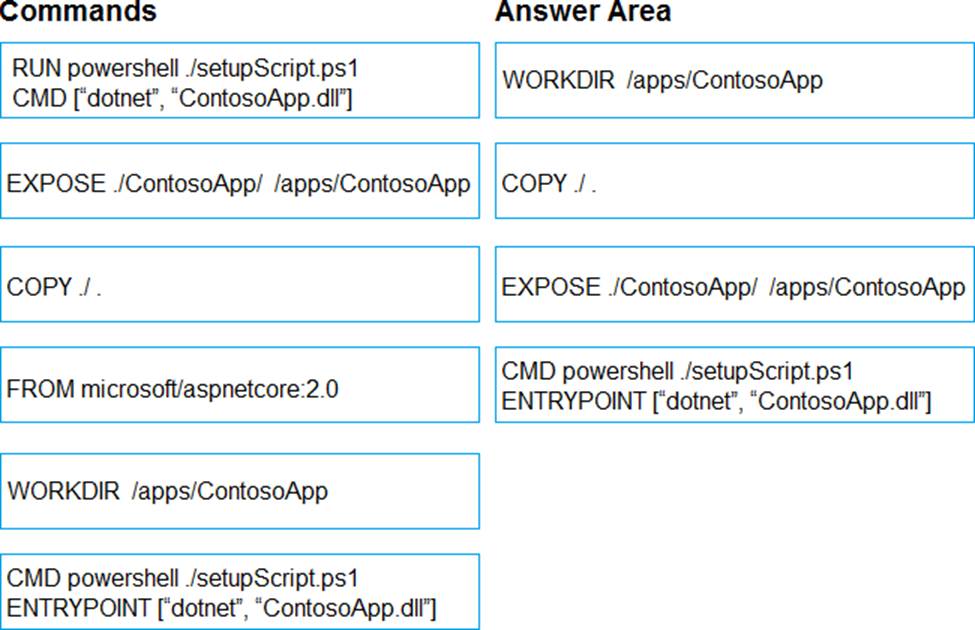Microsoft AZ-203 Developing Solutions for Microsoft Azure Online Training
Microsoft AZ-203 Online Training
The questions for AZ-203 were last updated at Apr 20,2025.
- Exam Code: AZ-203
- Exam Name: Developing Solutions for Microsoft Azure
- Certification Provider: Microsoft
- Latest update: Apr 20,2025
Testlet 1
Case Study
This is a case study. Case studies are not timed separately. You can use as much exam time as you would like to complete each case. However, there may be additional case studies and sections on this exam. You must manage your time to ensure that you are able to complete all questions included on this exam in the time provided.
To answer the questions included in a case study, you will need to reference information that is provided in the case study. Case studies might contain exhibits and other resources that provide more information about the scenario that is described in the case study. Each question is independent of the other question on this case study.
At the end of this case study, a review screen will appear. This screen allows you to review your answers and to make changes before you move to the next sections of the exam. After you begin a new section, you cannot return to this section.
To start the case study
To display the first question on this case study, click the Next button. Use the buttons in the left pane to explore the content of the case study before you answer the questions. Clicking these buttons displays information such as business requirements, existing environment, and problem statements. If the case study has an All Information tab, note that the information displayed is identical to the information displayed on the subsequent tabs. When you are ready to answer a question , click the Question button to return to the question.
Background
You are a developer for Proseware, Inc. You are developing an application that applies a set of governance policies for Proseware’s internal services, external services, and applications. The application will also provide a shared library for common functionality.
Requirements
Policy service
You develop and deploy a stateful ASP.NET Core 2.1 web application named Policy service to an Azure App Service Web App. The application reacts to events from Azure Event Grid and performs policy actions based on those events.
The application must include the Event Grid Event ID field in all Application Insights telemetry.
Policy service must use Application Insights to automatically scale with the number of policy actions that it is performing.
Policies
Log Policy
All Azure App Service Web Apps must write logs to Azure Blob storage. All log files should be saved to a container named logdrop . Logs must remain in the container for 15 days.
Authentication events
Authentication events are used to monitor users signing in and signing out. All authentication events must be processed by Policy service. Sign outs must be processed as quickly as possible.
PolicyLib
You have a shared library named PolicyLib that contains functionality common to all ASP.NET Core web services and applications.
The PolicyLib library must:
– Exclude non-user actions from Application Insights telemetry.
– Provide methods that allow a web service to scale itself
– Ensure that scaling actions do not disrupt application usage
Other
Anomaly detection service
You have an anomaly detection service that analyzes log information for anomalies. It is implemented as an Azure Machine Learning model. The model is deployed as a web service.
If an anomaly is detected, an Azure Function that emails administrators is called by using an HTTP WebHook.
Health monitoring
All web applications and services have health monitoring at the /health service endpoint.
Issues
Policy loss
When you deploy Policy service, policies may not be applied if they were in the process of being applied during the deployment.
Performance issue
When under heavy load, the anomaly detection service undergoes slowdowns and rejects connections.
Notification latency
Users report that anomaly detection emails can sometimes arrive several minutes after an anomaly is detected.
App code
Relevant portions of the app files are shown below. Line numbers are included for reference only and include a two-character prefix that denotes the specific file to which they belong.
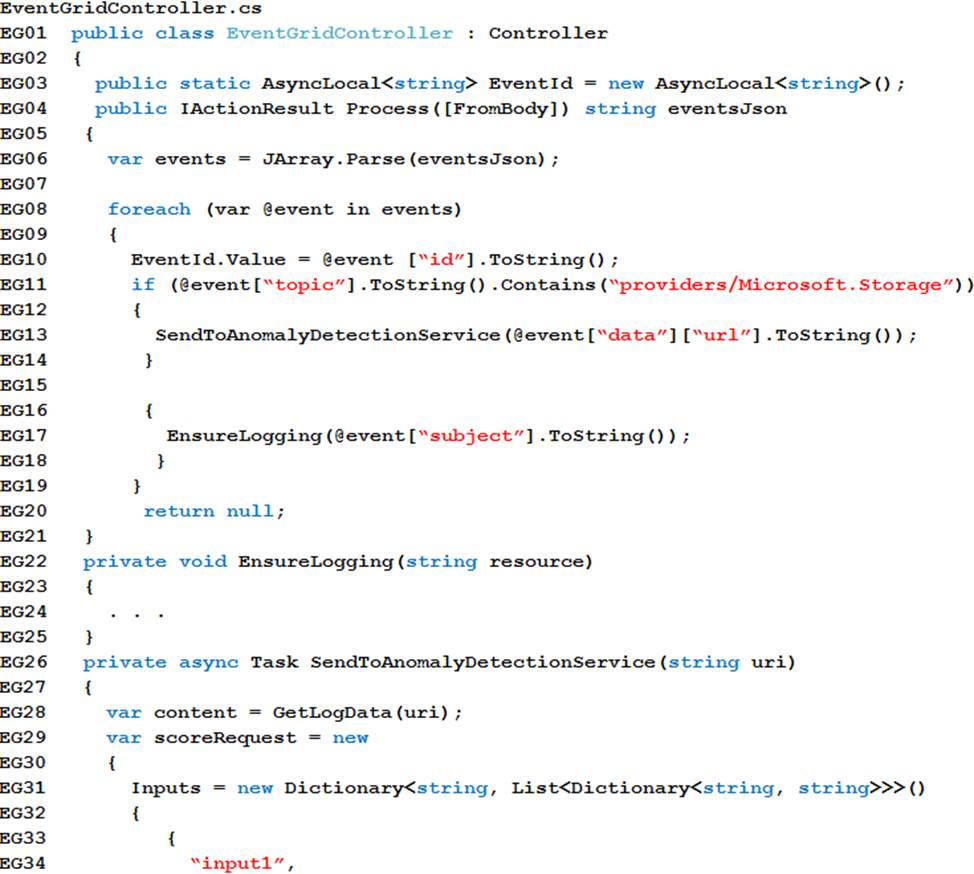
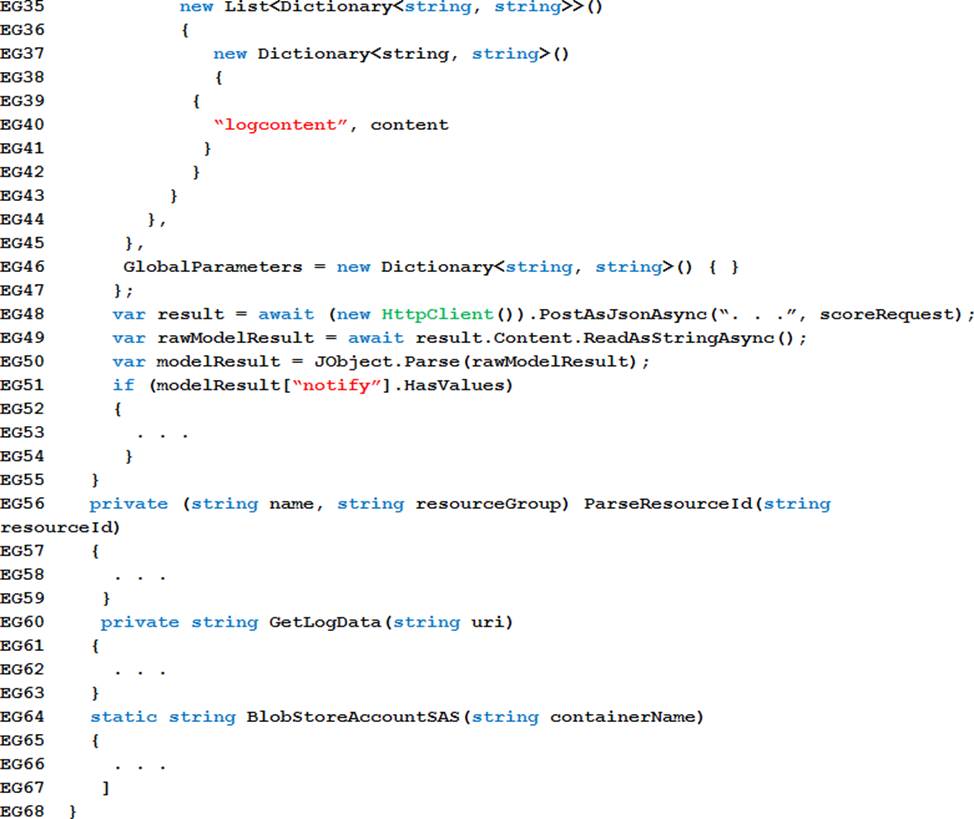
Relevant portions of the app files are shown below.
Line numbers are included for reference only and include a two-character prefix that denotes the specific file to which they belong.
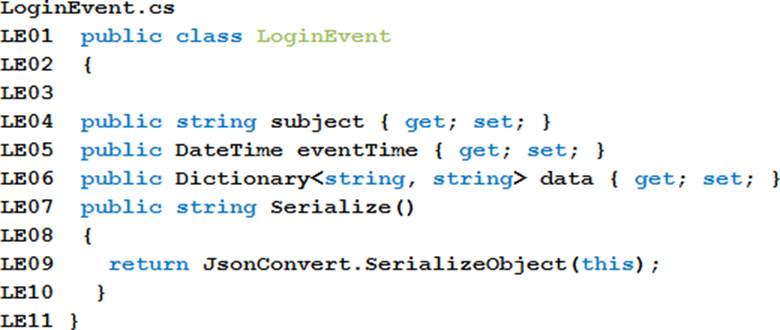
You need to resolve a notification latency issue.
Which two actions should you perform? Each correct answer presents part of the solution.
NOTE: Each correct selection is worth one point.
- A . Set Always On to false.
- B . Set Always On to true.
- C . Ensure that the Azure Function is set to use a consumption plan.
- D . Ensure that the Azure Function is using an App Service plan.
Testlet 2
Case Study
This is a case study. Case studies are not timed separately. You can use as much exam time as you would like to complete each case. However, there may be additional case studies and sections on this exam. You must manage your time to ensure that you are able to complete all questions included on this exam in the time provided.
To answer the questions included in a case study, you will need to reference information that is provided in the case study. Case studies might contain exhibits and other resources that provide more information about the scenario that is described in the case study. Each question is independent of the other question on this case study.
At the end of this case study, a review screen will appear. This screen allows you to review your answers and to make changes before you move to the next sections of the exam. After you begin a new section, you cannot return to this section.
To start the case study
To display the first question on this case study, click the Next button. Use the buttons in the left pane to explore the content of the case study before you answer the questions. Clicking these buttons displays information such as business requirements, existing environment, and problem statements. If the case study has an All Information tab, note that the information displayed is identical to the information displayed on the subsequent tabs. When you are ready to answer a question , click the Question button to return to the question.
LabelMaker app
Coho Winery produces bottles, and distributes a variety of wines globally. You are a developer implementing highly scalable and resilient applications to support online order processing by using Azure solutions.
Coho Winery has a LabelMaker application that prints labels for wine bottles. The application sends data to several printers. The application consists of five modules that run independently on virtual machines (VMs). Coho Winery plans to move the application to Azure and continue to support label creation.
External partners send data to the LabelMaker app lication to include artwork and text for custom label designs.
Requirements
Data
You identify the following requirements for data management and manipulation:
• Order data is stored as nonrelational JSON and must be queried using Structured Query Language (SQL).
• Changes to the Order data must reflect immediately across all partitions. All reads to the Order data must fetch the most recent writes.
Security
You have the following security requirements:
• Users of Coho Winery applications must be able to provide access to documents, resources, and applications to external partners.
• External partners must use their own credentials and authenticate with their organization’s identity management solution.
• External partner logins must be audited monthly for application use by a user account administrator to maintain company compliance.
• Storage of e-commerce application settings must be maintained in Azure Key Vault.
• E-commerce application sign-ins must be secured by using Azure App Service authentication and Azure Active Directory (AAD).
• Conditional access policies must be applied at the application level to protect company content.
• The LabelMaker application must be secured by using an AAD account that has full access to all namespaces of the Azure Kubernetes Service (AKS) cluster.
LabelMaker app
Azure Monitor Container Health must be used to monitor the performance of workloads that are deployed to Kubernetes environments and hosted on Azure Kubernetes Service (AKS).
You must use Azure Container Registry to publish images that support the AKS deployment.
Architecture
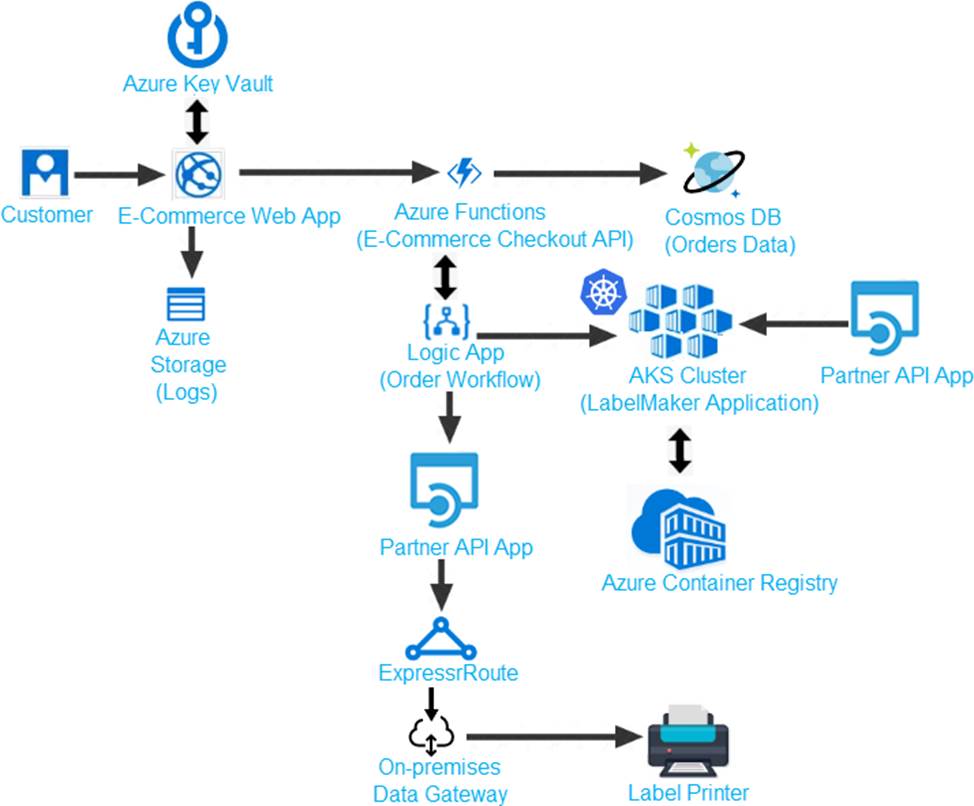
Issues
Calls to the Printer API App fail periodically due to printer communication timeouts.
Printer communications timeouts occur after 10 seconds. The label printer must only receive up to 5 attempts within one minute.
The order workflow fails to run upon initial deployment to Azure.
Order .json
Relevant portions of the app files are shown below. Line numbers are included for reference only.
This JSON file contains a representation of the data for an order that includes a single item.

HOTSPOT
You need to ensure that you can deploy the LabelMaker application.
How should you complete the CLI commands? To answer, select the appropriate options in the answer area. NOTE: Each correct selection is worth one point.
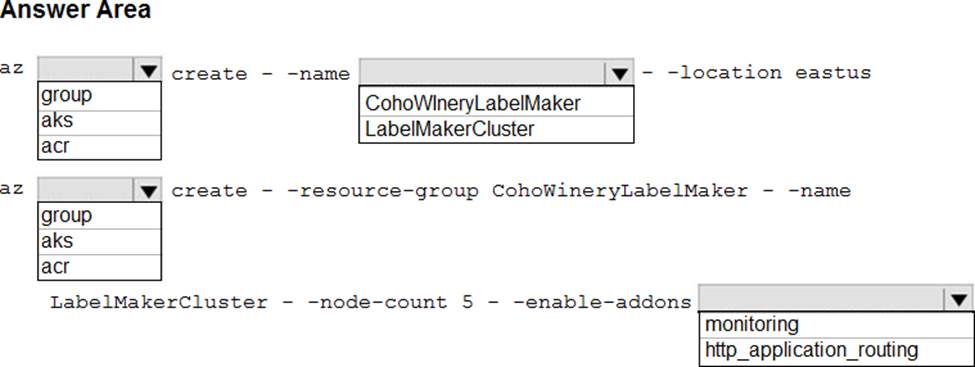
Testlet 3
Case Study
This is a case study. Case studies are not timed separately. You can use as much exam time as you would like to complete each case. However, there may be additional case studies and sections on this exam. You must manage your time to ensure that you are able to complete all questions included on this exam in the time provided.
To answer the questions included in a case study, you will need to reference information that is provided in the case study. Case studies might contain exhibits and other resources that provide more information about the scenario that is described in the case study. Each question is independent of the other question on this case study.
At the end of this case study, a review screen will appear. This screen allows you to review your answers and to make changes before you move to the next sections of the exam. After you begin a new section, you cannot return to this section.
To start the case study
To display the first question on this case study, click the Next button. Use the buttons in the left pane to explore the content of the case study before you answer the questions. Clicking these buttons displays information such as business requirements, existing environment, and problem statements. If the case study has an All Information tab, note that the information displayed is identical to the information displayed on the subsequent tabs. When you are ready to answer a question, click the Question button to return to the question.
Background
Wide World Importers is moving all their datacenters to Azure. The company has developed several applications and services to support supply chain operations and would like to leverage serverless computing where possible.
Current environment
Windows Server 2016 virtual machine
This virtual machine (VM) runs Biz Talk Server 2016.
The VM runs the following workflows:
– Ocean Transport C This workflow gathers and validates container information including container contents and arrival notices at various shipping ports.
– Inland Transport C This workflow gathers and validates trucking information including fuel usage, number of stops, and routes.
The VM supports the following REST API calls:
– Container API C This API provides container information including weight, contents, and other attributes.
– Location API C This API provides location information regarding shipping ports of call and truck stops.
– Shipping REST API C This API provides shipping information for use and display on the shipping website.
Shipping Data
The application uses MongoDB JSON document storage database for all container and transport information.
Shipping Web Site
The site displays shipping container tracking information and container contents. The site is located at http://shipping.wideworldimporters.com
Proposed solution
The on-premises shipping application must be moved to Azure. The VM has been migrated to a new Standard_D16s_v3 Azure VM by using Azure Site Recovery and must remain running in Azure to complete the BizTalk component migrations. You create a Standard_D16s_v3 Azure VM to host BizTalk Server.
The Azure architecture diagram for the proposed solution is shown below:

Shipping Logic App
The Shipping Logic app must meet the following requirements:
– Support the ocean transport and inland transport workflows by using a Logic App.
– Support industry-standard protocol X12 message format for various messages including vessel content details and arrival notices.
– Secure resources to the corporate VNet and use dedicated storage resources with a fixed costing model.
– Maintain on-premises connectivity to support legacy applications and final BizTalk migrations.
Shipping Function app
Implement secure function endpoints by using app-level security and include Azure Active Directory (Azure AD).
REST APIs
The REST API’s that support the solution must meet the following requirements:
– Secure resources to the corporate VNet.
– Allow deployment to a testing location within Azure while not incurring additional costs.
– Automatically scale to double capacity during peak shipping times while not causing application downtime.
– Minimize costs when selecting an Azure payment model.
Shipping data
Data migration from on-premises to Azure must minimize costs and downtime.
Shipping website
Use Azure Content Delivery Network (CDN) and ensure maximum performance for dynamic content while minimizing latency and costs.
Issues
Windows Server 2016 VM
The VM shows high network latency, jitter, and high CPU utilization. The VM is critical and has not been backed up in the past. The VM must enable a quick restore from a 7-day snapshot to include in-place restore of disks in case of failure.
Shipping website and REST APIs
The following error message displays while you are testing the website:
![]()
You need to support the requirements for the Shipping Logic App.
What should you use?
- A . Azure Active Directory Application Proxy
- B . Point-to-Site (P2S) VPN connection
- C . Site-to-Site (S2S) VPN connection
- D . On-premises Data Gateway
HOTSPOT
You need to configure Azure App Service to support the REST API requirements.
Which values should you use? To answer, select the appropriate options in the answer area. NOTE: Each correct selection is worth one point.
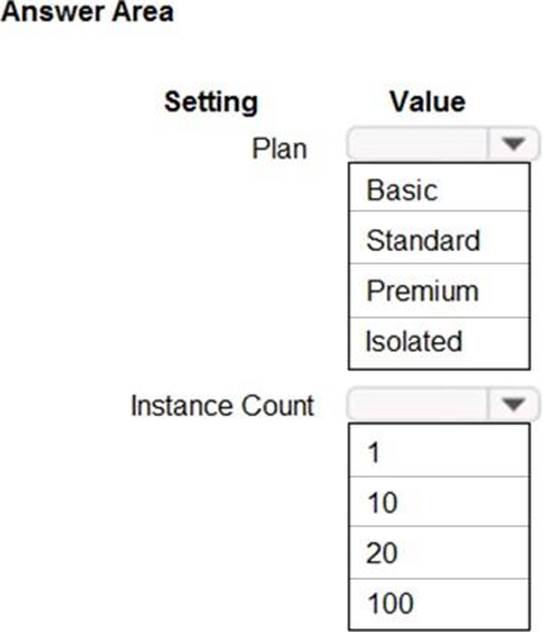
Question Set 4
You are writing code to create and run an Azure Batch job. You have created a pool of compute nodes. You need to choose the right class and its method to submit a batch job to the Batch service.
Which method should you use?
- A . JobOperations.EnableJobAsync(String, IEnumerable<BatchClientBehavior>,CancellationToken)
- B . JobOperations.CreateJob()
- C . CloudJob.Enable(IEnumerable<BatchClientBehavior>)
- D . JobOperations.EnableJob(String,IEnumerable<BatchClientBehavior>)
- E . CloudJob.CommitAsync(IEnumerable<BatchClientBehavior>, CancellationToken)
DRAG DROP
You are developing Azure WebJobs. You need to recommend a WebJob type for each scenario.
Which WebJob type should you recommend? To answer, drag the appropriate WebJob types to the correct scenarios. Each WebJob type may be used once, more than once, or not at all. You may need to drag the split bar between panes or scroll to view content. NOTE: Each correct selection is worth one point.
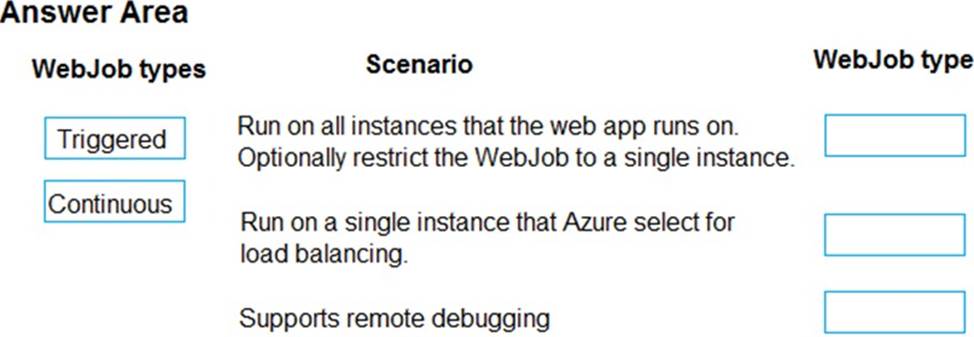
DRAG DROP
You are developing a software solution for an autonomous transportation system. The solution uses large data sets and Azure Batch processing to simulate navigation sets for entire fleets of vehicles. You need to create compute nodes for the solution on Azure Batch.
What should you do? Put the actions in the correct order.

DRAG DROP
You are deploying an Azure Kubernetes Services (AKS) cluster that will use multiple containers.
You need to create the cluster and verify that the services for the containers are configured correctly and available.
Which four commands should you use to develop the solution? To answer, move the appropriate command segments from the list of command segments to the answer area and arrange them in the correct order.
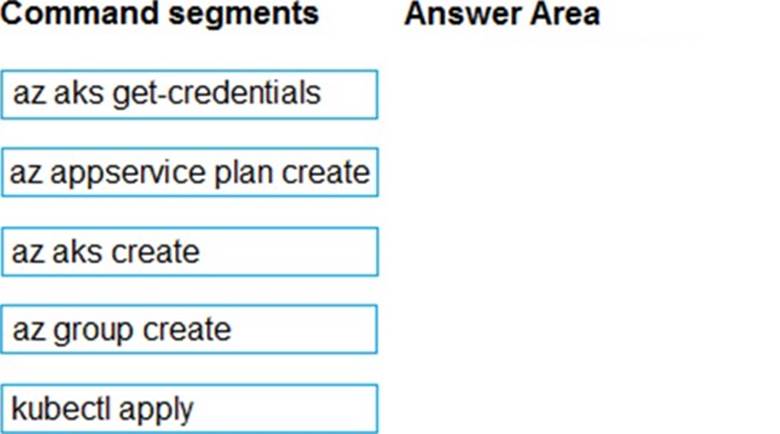
DRAG DROP
You are preparing to deploy a medical records application to an Azure virtual machine (VM). The application will be deployed by using a VHD produced by an on-premises build server.
You need to ensure that both the application and related data are encrypted during and after deployment to Azure.
Which three actions should you perform in sequence? To answer, move the appropriate actions from the list of actions to the answer area and arrange them in the correct order.
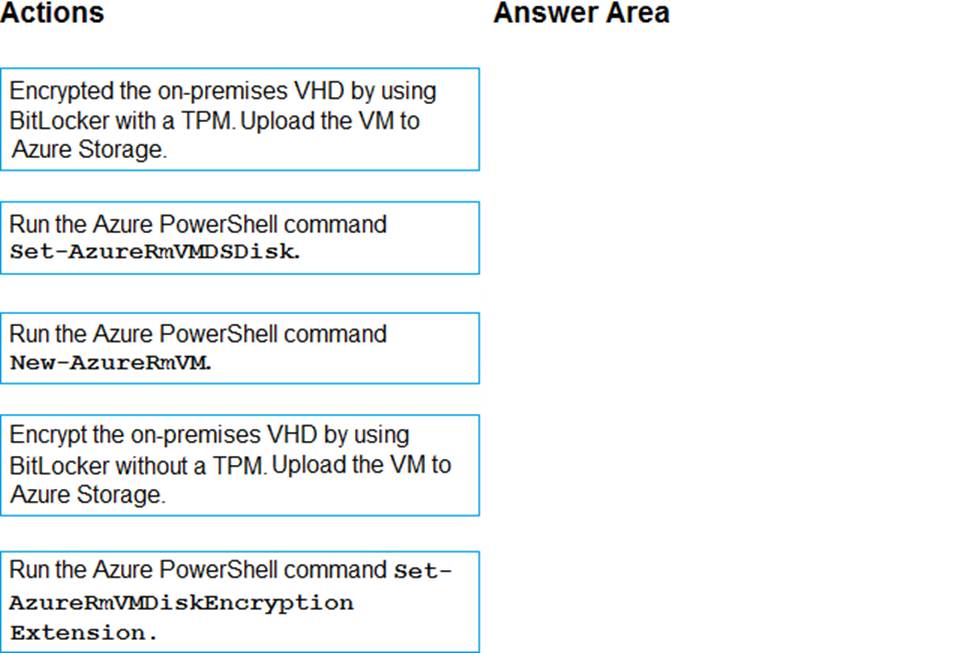
DRAG DROP
You plan to create a Docker image that runs as ASP.NET Core application named ContosoApp. You have a setup script named setupScript.ps1 and a series of application files including ContosoApp.dll.
You need to create a Dockerfile document that meets the following requirements:
– Call setupScript.ps1 when the container is built.
– Run ContosoApp.dll when the container starts.
The Dockerfile document must be created in the same folder where ContosoApp.dll and setupScript.ps1 are stored.
Which four commands should you use to develop the solution? To answer, move the appropriate commands from the list of commands to the answer area and arrange them in the correct order.
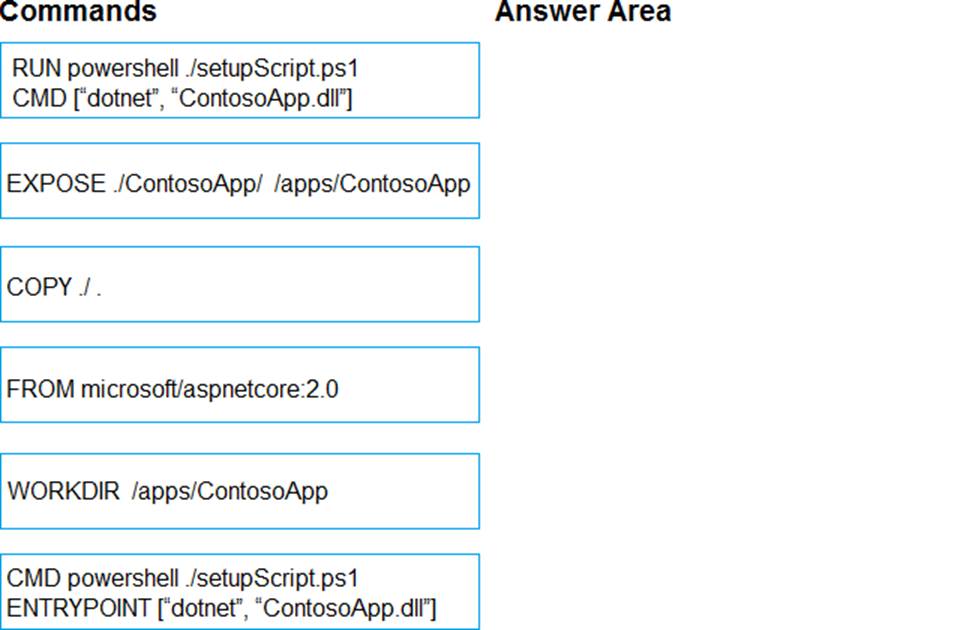
Latest AZ-203 Dumps Valid Version with 157 Q&As
Latest And Valid Q&A | Instant Download | Once Fail, Full Refund

